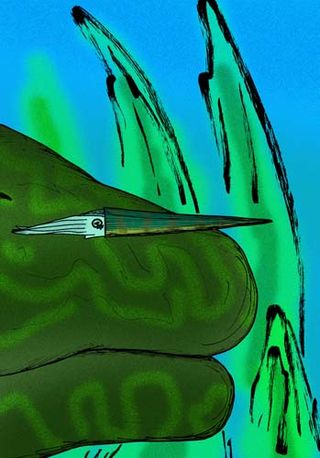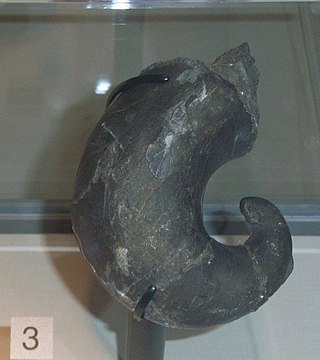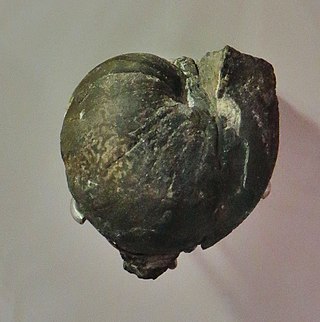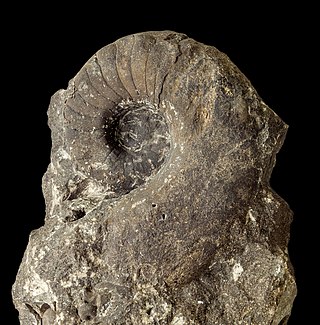Related Research Articles
Rayonnoceras is a genus of extinct cephalopods that lived around 325 million years ago during the Carboniferous. Although they resemble earlier actinocerids they are now thought to belong to the Pseudorthocerida

Orthocerida, also known as the Michelinocerida, is an order of extinct orthoceratoid cephalopods that lived from the Early Ordovician possibly to the Late Triassic. A fossil found in the Caucasus suggests they may even have survived until the Early Cretaceous, and the Eocene fossil Antarcticeras is sometimes considered a descendant of the orthocerids although this is disputed. They were most common however from the Ordovician to the Devonian.
Michelinoceras is the oldest known genus of the Michelinocerida, more commonly known as the Orthocerida, characterized by long, slender, nearly cylindrical orthocones with a circular cross section, long camerae, very long body chambers, and a central or near central tubular siphuncle free of organic deposits. Septal necks are straight; connecting rings cylindrical and thin. Cameral deposits are well developed. A radula has been found in one species, with seven teeth per row. It had ten arms, two of which formed longer tentacles.

Ormoceras is an actinocerid nautiloid genus and type for the family Ormoceratidae, found in North America from the late Chazyan through the early Cincinnatian of the Middle and Upper Ordovician, but which continued through the Devonian worldwide.

The Oncocerida comprise a diverse group of generally small nautiloid cephalopods known from the Middle Ordovician to the Mississippian, in which the connecting rings are thin and siphuncle segments are variably expanded. At present the order consists of some 16 families, a few of which, such as the Oncoceratidae, Brevicoceratidae, and Acleistoceratidae contain a fair number of genera each while others like the Trimeroceratidae and Archiacoceratidae are represented by only two or three.

Lamellorthoceratidae is a family of fossil orthoceratoids in the Orthocerida, defined by Curt Teichert in 1961. The lamellorthoceratids are placed in the superfamily Orthocerataceae in the Treatise on Invertebrate Paleontology.

Prolecanitida is an order of extinct ammonoid cephalopods, the major Late Paleozoic group of ammonoids alongside the order Goniatitida. Prolecanitids had narrow shells, discoidal (disc-shaped) to thinly lenticular (lens-shaped). They retained a retrochoanitic siphuncle, a simple form with septal necks extending backwards. As is typical for ammonoids, the siphuncle sits along the ventral margin of the shell.
Paraloxoceras is a genus of straight shelled, orthoconic nautiloid cephalopods, now extinct, that lived during the Early Carboniferous. Fossils have been found in Europe and central Asia; the type, P. konincki, named by Flower, came from Belgium.
Pseudactinoceras is an extinct nautiloid cephalopod included in the order Pseudorthocerida and the namesake of the family Pseudactinoceratidae.

Cycloceras is an extinct nautiloid cephalopod genus from the Carboniferous of Western Europe, of unknown affinity with the Orthocerida.
Carbactinoceratidae is a family of extinct cephalopods with external shells that lived around 325 million years ago, during the Carboniferous period. They were the last group of orthocones to attain sizes exceeding one meter in length. One specimen of the carbactinoceratid species Rayonnoceras solidiforme, recently found in Arkansas, was measured at 2.5 metres (8.2 ft) long.
The Centroceratidae is the ancestral family of the Trigonoceratoidea and of the equivalent Centroceratina; extinct shelled cephalopods belonging to the order Nautilida

The Aipoceratoidea are a superfamily within the order Nautilida characterized by rapidly expanding, smooth to ribbed, cyrtoconic to coiled shells with rounded or sometimes dorsally flattened or impressed whorls, nearly straight sutures, and a ventral and marginal siphuncle. Septal necks are orthochoanitic ventrally and orthochoanitic or cyrtochoanitic dorsally.
Shimanskya is a late Carboniferous fossil tentatively interpreted as an early spirulid.

Phragmoteuthida is an order of extinct coleoid cephalopods characterized by a fan-like teuthoid pro-ostracum attached to a belemnoid-like phragmocone.

Peripetoceras is a genus in the Clydonautilacean family, Liroceratidae. It can be recognized by its smooth, involute shell with a deep small umbilicus with rounded shoulders and steep convex wall; whorl section with flattened venter, rounded ventral shoulders and convergent slightly convex flanks; suture with slight ventral and lateral lobes; and small siphuncle located dorsally of the center.

Metacoceras is a nautilitoid cephalopod from the Upper Carboniferous (Pennsylvanian) and Permian, the shell of which is moderately evolute with a subquadrate whorl section, bearing nodes on the ventral or umbilical shoulders or both, but otherwise smooth. The siphuncle is small, subcentral and orthochoanitic. The suture has shallow ventral and lateral lobes but no dorsal or annular lobe.
Poterioceratidae is a family of nautiloid cephalopods included in the Oncocerida that lived during the period from the Early Devonian to the Early Carboniferous (Mississippian). Members of the Poterioceratidae are distinguished by a subcircular to compressed exogastric shell that has no hyponomic sinus and a central to subcentral siphuncle composed of subquadrate to nummuloidal segments in which the septal necks are more strongly curved on the upper, or dorsal side. This is opposite from the Karoceratidae in which siphuncle segments are inflated ventrally but straight dorsally. Some poterioceratid genera have actinosiphonate structures or annular deposits within the siphuncle. In others it is empty.
Carbactinoceras is a genus of Early Carboniferous (Visean) actincoceroids first found in Europe (Germany) related to Rayonnoceras but probably smaller.
Solenochilidae is a small family of Carboniferous and Early Permian nautilids, similar and related to the Aipoceratidae that comprises genera with whorls in contact and which develop laterally projecting umbilical spines by maturity. The included genera Solenochilus and Acanthonautilus are quite similar in external form but differ in their siphuncles. Those of Solenochilus have more strongly inflated siphuncle segments and more tightly curved septal necks.
References
- Walter C Sweet, 1964. Nautiloidea -Orthocerida; Treatise on Invertebrate Paleontology, Part K. Geological Society of America and University of Kansas Press.
- Eusthenoceras in the Paleobiology database, 4/25/14